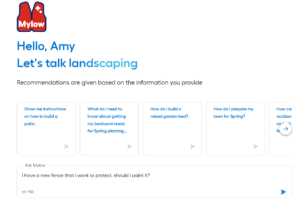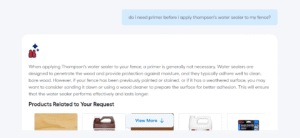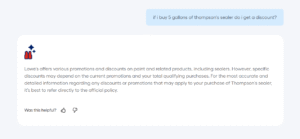 Retailers have been experimenting with AI-powered chatbots for years, but with the introduction of generative AI, the bar has been raised. Customers now expect assistants that don’t just point them to static FAQs but actually understand their questions and deliver relevant, trustworthy answers. Lowe’s recently introduced a promising entry into this space: Mylow, a virtual home improvement assistant built in partnership with OpenAI.
Retailers have been experimenting with AI-powered chatbots for years, but with the introduction of generative AI, the bar has been raised. Customers now expect assistants that don’t just point them to static FAQs but actually understand their questions and deliver relevant, trustworthy answers. Lowe’s recently introduced a promising entry into this space: Mylow, a virtual home improvement assistant built in partnership with OpenAI.
Mylow is designed to help customers plan projects, get product recommendations, and explore ideas for everything from backyard landscaping to painting and staining. Unlike general-purpose AI tools like ChatGPT or Perplexity, Mylow is purpose-built. It sits within the Lowe’s ecosystem, tailored to address home improvement needs with responses aligned to the company’s product offerings and terminology. The assistant is only available to registered Lowe’s users, which hints at a longer-term goal: to integrate customer history, store availability, and promotions into a deeply personalized shopping experience.
For now, the experience feels like a hybrid between a helpful sales associate and an interactive product guide. It already handles “how-to” questions quite well—offering project prep suggestions, application tips, and curated product lists. But the real opportunity lies ahead: connecting Mylow to real-time data and proprietary systems to create the kind of assistant that’s not just useful, but essential.
Trying It Out in the Real World
 I decided to test Mylow myself after seeing it mentioned in Lowe’s corporate blog. Coincidentally, I was already at Lowe’s over the weekend picking up stain for a new fence. The store had a promotion on its website—15% off when you buy 5 gallons of a specific tinted water sealer.
I decided to test Mylow myself after seeing it mentioned in Lowe’s corporate blog. Coincidentally, I was already at Lowe’s over the weekend picking up stain for a new fence. The store had a promotion on its website—15% off when you buy 5 gallons of a specific tinted water sealer.
Curious how useful Mylow would be in this situation, I signed up online and asked a few questions. When I asked whether I needed a primer before applying Thompson’s water sealer, the assistant gave a clear and accurate answer. It even suggested related products, which felt like a natural way to guide a novice through an outdoor project.
But when I asked Mylow about the in-store promotion—whether I’d get a discount for buying five gallons—it gave me a generic response about how Lowe’s sometimes offers discounts on sealers and that I should check the website. It didn’t mention the actual promotion I had seen. This was a missed opportunity. Connecting Mylow to active promotions or customer purchase history would make it far more useful and reinforce its value as a trusted shopping companion.
 That’s not to say the tool isn’t promising. The fact that it exists at all—and that it was built directly in partnership with OpenAI—is a big signal. Large enterprises are no longer looking exclusively to specialized conversational AI providers for these types of services. They’re going directly to LLM providers and building proprietary experiences tailored to their brand and customer base.
That’s not to say the tool isn’t promising. The fact that it exists at all—and that it was built directly in partnership with OpenAI—is a big signal. Large enterprises are no longer looking exclusively to specialized conversational AI providers for these types of services. They’re going directly to LLM providers and building proprietary experiences tailored to their brand and customer base.
What Self-Service Designers Can Learn from Mylow
The lesson here is clear: Generative AI has changed the self-service playbook.
Customers are already trained on how to use AI assistants. They expect natural language interfaces that “just work.” But to win them over, companies need to go beyond general knowledge and plug their assistants into what only the business can provide: inventory, promotions, location-aware answers, and account-level personalization.
Lowe’s also rolled out Mylow Companion, a GenAI-powered assistant for store associates. This version lives on handheld devices and helps employees answer questions, check product details, and walk customers through project steps—even if they’re new to the job. Together, these two tools—customer-facing Mylow and in-store Mylow Companion—showcase a dual-front strategy: elevate the experience on both sides of the counter.
The technology is here. What comes next is the hard part: connecting it to the right systems, permissions, and context to make AI a first-class citizen in the customer journey.
Categories: Articles

 Getting It Right: What AI Agents Actually Mean for Customer Support (Webinar)
Getting It Right: What AI Agents Actually Mean for Customer Support (Webinar)  Beyond the Basics: How AI Is Transforming B2B Sales at TP
Beyond the Basics: How AI Is Transforming B2B Sales at TP  Five9 Launches Agentic CX: Toward AI Agents That Reason and Act
Five9 Launches Agentic CX: Toward AI Agents That Reason and Act  2025 Conversational AI Intelliview: Decision-Makers Guide to Self-Service & Enterprise Intelligent Assistants
2025 Conversational AI Intelliview: Decision-Makers Guide to Self-Service & Enterprise Intelligent Assistants